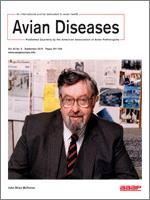Avian pathogenic Escherichia coli (APEC) is the causative agent of colibacillosis in poultry, an economically important disease worldwide. In Ontario, Canada, early and late systemic bacterial infections due to APEC were the most commonly reported diseases in broiler chickens. In 2016, Ontario poultry veterinarians submitted samples from 331 cases of broiler and broiler breeder chickens with a high suspicion of colibacillosis to the Animal Health Laboratory (Guelph, Ontario, Canada) for bacterial culture. Escherichia coli isolates from those samples were tested with multiplex PCR to detect the presence of 13 virulence-associated genes. The most common genes identified were sitA (detected in 93% of isolates), iss (88%), iroN (85%), iutA (79%), ompT (77%), and etsB (67%). In 94% of isolates, at least three virulence-associated genes were detected. Antimicrobial susceptibility testing of isolates by using the disk diffusion method revealed high frequencies of resistance to tetracycline (57% of isolates), gentamicin (50%), spectinomycin (46%), and ampicillin (44%). Relatively fewer isolates were resistant to trimethoprim-sulfamethoxazole (18%), ceftiofur (15%), kanamycin (11%), and apramycin (3%). A high proportion (46%) of the isolates were multidrug resistant (≥3 antimicrobial classes). On the basis of multivariable, mixed effects logistic regression models, statistically significant associations (P ≤ 0.05) were identified between the following: ampicillin resistance and the presence of kpsII (odds ratio [OR] = 1.88), tsh (OR = 0.46), and ireA (OR = 0.32); ceftiofur resistance and etsB (OR = 2.98) and kpsII (OR = 2.61); gentamicin resistance and ompT (OR = 3.89) and sitA (OR = 3.54); kanamycin resistance and papC (OR = 50.10); spectinomycin resistance and ireA (OR = 2.50) and iutA (OR = 3.15); trimethoprim-sulfamethoxazole resistance and ompT (OR = 0.14) and tsh (OR = 0.31); and tetracycline resistance and cvaC (OR = 2.12), eitA (OR = 2.15), and papC (OR = 8.27). On the basis of a multivariable, mixed effects Poisson regression model, the number of antimicrobials to which an isolate was resistant increased with the presence of eitA (risk ratio [RR] = 1.37), iroN (RR = 1.24), papC (RR = 1.34), and sitA (RR = 1.77) and decreased with the presence of tsh (RR = 0.79). On the basis of bivariable logistic regression models, age group and time of sample collection were not significantly associated with resistance to individual antimicrobials, the presence of multidrug resistance, or the presence of virulence-associated genes. Our results provide information on antimicrobial resistance and virulence gene patterns currently present on Ontario broiler chicken and broiler breeder farms that can be used as a benchmark from which to measure changes.
How to translate text using browser tools
4 May 2018
Evaluating Virulence-Associated Genes and Antimicrobial Resistance of Avian Pathogenic Escherichia coli Isolates from Broiler and Broiler Breeder Chickens in Ontario, Canada
Csaba Varga,
Marina L. Brash,
Durda Slavic,
Patrick Boerlin,
Rachel Ouckama,
Alexandru Weis,
Mike Petrik,
Cynthia Philippe,
Melanie Barham,
Michele T. Guerin
ACCESS THE FULL ARTICLE

Avian Diseases
Vol. 62 • No. 3
September 2018
Vol. 62 • No. 3
September 2018
antimicrobial resistance
avian pathogenic Escherichia coli
broilers
Canada
multidrug resistance
Ontario
virulence genes




